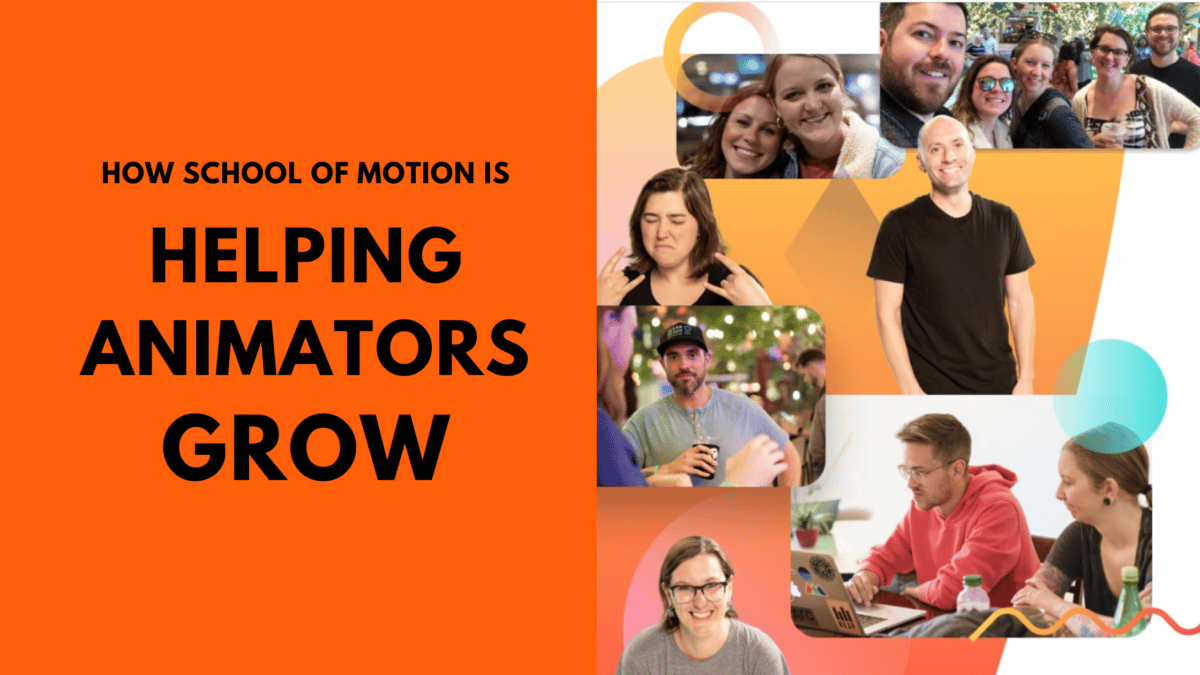A rapidly changing industry needs skilled professionals to keep pushing the boundaries of what it can achieve. Animation is no exception. From commercials to art films and everything in between, animation requires technical skill and a unique perspective. But how do new and experienced animators build the skills they need to succeed in this dynamic industry?
Many turn to School of Motion, an online motion design program. We chatted with their Marketing Director, Holly Fong, to get a behind-the-scenes look at the school’s students, structure, and philosophy of animation.
What is School of Motion?
School of Motion guides students through an exploration of animation and design software, including Cinema 4D, Adobe Photoshop, Illustrator, and After Effects. They offer 3D, 4D, VFX, and drawing courses, all with a solid grounding in animation theory.
“Our goal is to provide a realistic curriculum that doesn’t just teach you how to use the software, but how to use it successfully in your career,” Fong said.
Students come from all different backgrounds. Some are novice animators with no hands-on experience. Others are experts in their field who want to keep up to date with the latest technology and techniques.
These students go on to create everything from VFX for feature films to the user interface for smartphone apps. As more companies use animation in advertisements, websites, and short films, the demand for skilled motion designers is growing. Students of School of Motion go on to design for global media titans, Fortune 500 companies, and private clients.
Animation and Design Fundamentals
“These courses are not easy, and that’s by design,” Fong says. “We’re presenting you with a challenge but also ensuring that you have all the tools needed to succeed.”
Fong says instructors are the foundation of School of Motion’s programs. They have decades of experience working for big studios and high-profile clients. Relying on that expertise, they guide students through multi-week, interactive courses and assignments based on real-world projects.
Their programs are structured around helping students get comfortable with the fundamentals of animation and design. “Learn those well, and you’ll be able to find your way through any tool you come up against,” Fong said.
The cohort-based structure means that students always have a group of like-minded artists to learn with. Artists share their work and connect with students and alumni on The Square, a social media platform hosted by School of Motion.
Each student also gets a Teaching Assistant, a veteran designer who provides one-on-one feedback as well as technical and creative support. Fong stresses that students should always be open to feedback. “You may be an incredible artist, but there are always areas to improve,” Fong said.
More than animation software
Instructors and TA’s stay at the cutting edge of animation technology by working on their own personal and professional projects. But technology is just part of the equation.
“Animation, at its core, is really about conjuring life into otherwise static imagery,” Fong said.
The core fundamentals students learn become their toolkit for breathing life into their characters. But the life students are living is equally important.
“Simply put, you have to bring your own voice into your artwork,” Fong said. “That means having a point of a view, a story, or just a point to make with your art. Even if you’re just animating two Styrofoam cups in a dumpster in order to sell soda, you have to have a perspective.”
Overconsumption is an easy trap to fall into. In an attempt to learn as much as possible, students may watch everything, internalize every reference, become experts at every tool. Yet, this intense focus on what others are saying can result in animators just repeating old patterns. School of Motion is built on the idea that students must put themselves into the work.
“Animation really needs more of the individual artists showing up in the final project,” Fong said.
This video holiday card by School of Motion alumni gives you a sense of what “individual artists showing up” can look like.
Art, business, and showmanship
School of Motion instructors recognize that animation is both an art and a business. To succeed at both, students need to be able to tell their own stories. It’s the only way to find an audience for your work.
“Whether that’s a client to hire you, a brand with a problem to solve, or an NFT collector to support your own art, understanding how to tell YOUR OWN story and take advantage of social media to get that story out into the world is quickly becoming another skill animators need to understand,” Fong said.
And the school is doing its part to help students position themselves in the marketplace. They offer a course called Demo Reel Dash, which helps experienced animators create a demo real and campaign that showcases their work. School of Motion also sponsors a job board to connect alumni with employers.
How to prepare for a career in animation
Of course, Fong encourages those seeking a career in animation to enroll at School of Motion, but she also points out a few ways that professionals can help build their skills outside of school:
- Look for ways to improve your understanding of fundamental concepts like storytelling, lighting, and color.
- Cultivate an interest in related arts like dance, music, or editing to develop your sense of timing and rhythm.
- Explore photography to build image composition skills.
Whatever you do, keep seeking ways to grow and expand your skills. The world of animation is always expanding, we’re excited to see what you bring to it.




